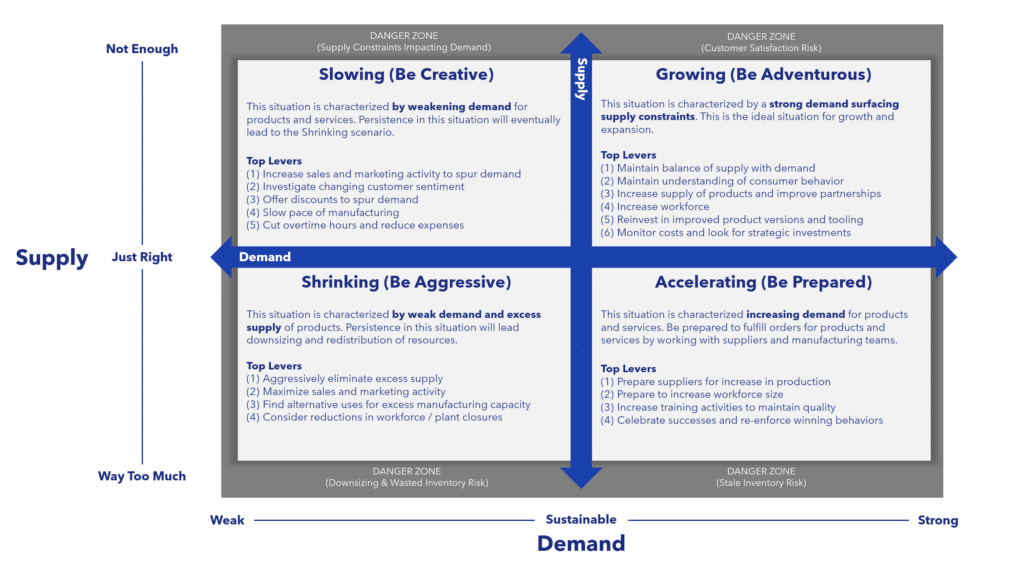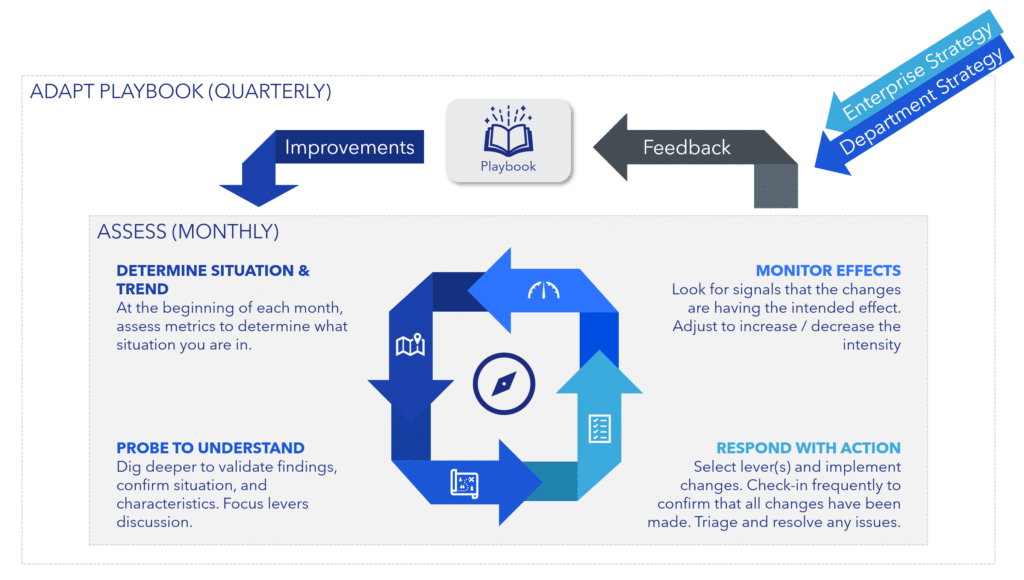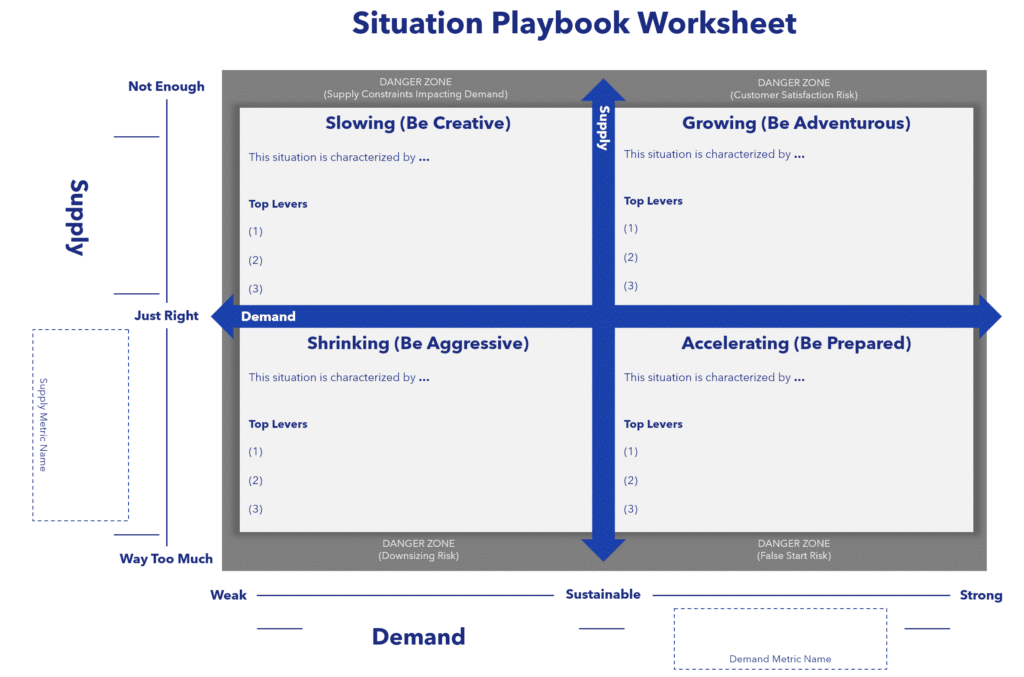Without a doubt, change happens more rapidly than it used to. There used to be time for leaders to analyze a situation, get multiple perspectives, and make a decision that balanced the needs of multiple parties. Now, there is a sense of urgency to act, or you might miss an opportunity to grow your business, or maybe it is more dire, you need to act, or you might have to let go of hard-working people in your organization. These types of decisions are hard and must be approached carefully and with consideration of the impact on the organization.
You might hear in your leadership meetings, “What levers should we pull?” to begin a discussion of the actions to take to correct a situation. For example, “We aren’t meeting our sales target. What levers should we pull?” In this example, a member of the leadership team wants to get a few ideas for how to solve the problem. As you already know, these conversations can be very frustrating as you see each member of the team offer ideas. The group cycles through them, “Oh, we’ve tried that before, and it didn’t work.” How many hours has your leadership team spent discussing topics like this while you are thinking, “Haven’t we solved this before?”
Although these conversations can be intellectually stimulating and involve problem-solving, a recurring thought may cross your mind: haven’t we encountered this issue before? What actions did we take in the past? Did those strategies yield positive results? It becomes increasingly evident that the lessons learned from previous experiences should guide us towards improved performance in the future. But where are those answers? Did anyone capture them? Was anyone here when that happened?
In sports, teams must make decisions quickly, most of the time in real-time, or they risk losing the game. In business, it feels like our decision window is getting closer and closer to real-time. The longer a decision is delayed, the larger the impact. Professional sports teams build and utilize playbooks containing strategies categorized by situation to help them navigate a variety of situations to increase their chances of winning the game.
Leaders already face a demanding schedule, and the prospect of recurrent leadership meetings being dominated by debates over problems that have been resolved in the past is a matter of concern. The question then becomes, how can we as leaders proactively address this issue and streamline our decision-making processes to make better decisions when time matters?
Impacts of delayed decision-making
Success hinges on having predefined playbooks for common scenarios, fostering an organized and effective response to challenges. The speed at which we respond to evolving situations significantly influences impacts on customer, investor, and employee sentiments, as well as the overall morale of the leadership team. Delays in decision-making can even hinder the company’s ability to “turn the ship around.” The longer it takes to reach a decision, the more devastating the impacts become, making the “time to heal” even longer.
For your organization, what were the impacts of a delay? Did you wait too long to reassign an underperforming team member, which impacted your leadership credibility? Did you keep hiring as demand slowed, and now you must consider a layoff to get costs under control? We’ve all been there; it’s terrible, the decision is hard, and you want more information, but the fact remains – a decision must be made, it must be timely, and the longer you delay, the harder it gets.
A better way to streamline decision-making
Continuous monitoring and adaptation of playbooks are crucial to ensure a proactive and well-prepared response to changing business situations. Playbooks have documented responses to common scenarios, analogous to the way sports teams use playbooks, full of plays for a variety of situations, memorized by each team member, and used strategically to win games. A playbook approach helps leadership teams streamline decision-making processes to make better decisions informed by past actions, enabling them to make both effective and timely decisions where time is crucial. Many leadership concerns fundamentally revolve around the management of supply and demand dynamics. A straightforward quadrant model can be a valuable tool at the organizational, departmental, and/or product/service line level to address these issues. When supply and demand fall out of balance, it signals the need for systemic adjustments to restore equilibrium, emphasizing the importance of having a playbook with top actions to quickly restore operational equilibrium.

Five steps to enable better decision-making
The goal is to optimize how fast leadership teams can make decisions while maintaining and even improving the quality of decisions. So, what is a quality decision? According to the HBR Article, “How to Make Great Decisions, Quickly”, a great decision has 8 elements.
- Great decisions are made as close as possible to the action
- Great decisions address the root cause, not just the symptoms
- Great decisions are shaped by consideration of many different viewpoints
- Great decisions are made by a clearly accountable person
- Great decisions consider the holistic impacts of a problem
- Great decisions balance short-term and long-term value
- Great decisions are communicated well to stakeholders
- Great decisions are timely
Implementing a situational playbook
To streamline great decision-making, we recommend employing a situational playbook to capture the top actions for each type of situation. Many problems in business are supply and demand mismatches, so there are four quadrants to represent each type of situation (Growing, Slowing, Shrinking, and Accelerating). Taking a data-driven approach, you can use your own supply and demand metrics to plot which quadrant you are in and where you might be headed. This sets the right situational context for your leadership team to have productive and focused discussions to determine “what levers to pull.”
To make a lasting impact on your organization, establish a systematic approach to periodically assess the organization’s current situation and revise the playbook based on what worked best last time. This continuous monitoring and continuous improvement approach ensures that the playbook’s top actions are effective and aligned with enterprise goals so that your leadership team continues to benefit from past actions while aligning with the corporate strategy.
Your leadership team should meet regularly to assess the situation of the business using a playbook, regardless of whether you sense change or not:
- Determine Situation & Trend
- Quickly Probe to Understand
- Respond with Action
- Measure Effects
- Adapt Situation Playbook Quadrants
The frequency of these checkpoints should be selected based on the speed of change happening in your business. Consider a monthly cadence as a good starting point.

1. Determine Situation & Trend
To maintain a well-informed and responsive leadership posture, it is essential for your team to routinely review supply and demand metrics and determine the situation you are in and towards which situation quadrant you are heading. Leadership teams would complete this step on a recurring basis – frequency depends on the speed of change in your organization; this could be a weekly, monthly, or quarterly evaluation. The evaluation should encompass both leading indicators, such as the sales pipeline, and lagging indicators, like revenue. While this process may initially appear mundane, its significance lies in fostering a shared interpretation of these metrics (and trends) and their implications within your organizational context. This collective understanding narrows the scope of levers open for discussion and facilitates a more rapid and targeted response to changing circumstances.
Establishing this routine assessment of supply and demand metrics equips your leadership team with the tools to adapt proactively, ensuring that your whole leadership team comprehends its current situation. This, in turn, paves the way for more efficient decision-making and faster responses to emerging challenges and opportunities.
2. Quickly Probe to Understand
Organizations are complex, and metrics always have a backstory (and can sometimes be misleading). Quickly probe both supply and demand metrics to gain a deeper understanding of the current situation and see if you can spot a trend. Use both leading and lagging indicators to confirm which situation you are in. Understanding the reasons and mechanisms that led you to this point is crucial for informed decision-making. Moreover, these indicators provide a clear trajectory, shedding light on the direction in which your business is headed. For example, if inventories (supply) are rising, is it because manufacturing is ahead of schedule or are sales (demand) slipping?
The goal is to move quickly, sequence, and prioritize your leading and lagging indicators so you can efficiently “drill down” or “click in” to supporting data so you can plot your situation and narrow your “which levers should we pull” discussion. Document your preferred metrics for supply and demand. Using a combination of leading and lagging indicators and both quantitative and qualitative data points empowers your team to not only identify our current situation but also to proactively shape the path ahead.
Consider structuring your conversation using frameworks like the following:
- 4 Ps of Marketing (Product, Price, Place, Promotion)
- Supply Chain SCOR Model (Plan, Source, Make, Deliver, Return, Enable)
- 5 Whys Method
- Sales KPIs and Sales Funnel metrics
3. Respond with Action
Having gained a deeper understanding of the business’s current situation, potential contributing factors, and projected trajectory, the next step involves a thoughtful examination and discussion of the recommended levers tailored to address the existing situation. It is pivotal to carefully choose one or more levers best suited to your circumstances and initiate their implementation.
For example, let’s say your metrics show that you are in the “Slowing” situation, and your top action is to freeze expenses. Now you can have a thorough discussion with your leadership team to explore the pros/cons, effectiveness, and risks of an action. What effect are you trying to create? What is the target? Who is impacted by the change? Will this action prevent any future actions? How do you mitigate against unintended consequences?
4. Measure Effect
A critical aspect of this process is ensuring that each selected lever is measurable, allowing for a clear assessment of its impact. These more detailed metrics provide indicators of whether your action is working and to what extent.
For example, if you choose to cut costs to save $200k this month, you will want to make sure cost savings are on track. You do not want to end the month off target with only $10k in savings or over $500k in savings or may expose unintended consequences.
5. Adapt Situation Playbook Quadrants
Regularly measure and review the efficiency of the levers chosen and make necessary adjustments within the Situation Quadrant to align with the conditions at the time when each lever was activated. Depending on the efficacy of the selected lever, you have the flexibility to either eliminate it from consideration, modify its level of priority, or introduce a more effective alternative.
As time progresses, your customer base, products, suppliers, employees, and investors will change, necessitating an update to your levers to accommodate these evolving realities. Consistently monitoring and updating the Situation Quadrant, with which levers worked and which ones did not, is essential to ensuring that your leadership team remains well-prepared to swiftly respond to rapidly shifting external influences in the future.
Your path forward
Establishing a trusted playbook for alignment, swift responses, and the safeguarding of mission and interests. This ensures a proactive stance in tackling situational challenges and aligning leadership teams effectively.
For some, this might come across as a fresh perspective on aligning leadership teams and tackling situational challenges, while for others, it may appear to be a straightforward process. This discrepancy in perception is precisely what often leads to a deadlock in discussions within leadership teams. What is crucial is the establishment of a trusted playbook that everyone can rally behind, enabling swift responses and safeguarding your mission and the interests of customers, employees, suppliers, and investors.
Steps to get started
- Fill out the Situation Playbook Worksheet
- Determine what metrics your group uses for “Supply” and “Demand;” what is good and what is bad for each
- For each situation, document the levers you have pulled in the past for each situation
- Conduct an initial assessment and share it with a peer for feedback
- Incorporate feedback and repeat assessment to increase confidence
- Make this a recurring checklist item in your leadership meetings
Download a copy of the Situation Playbook Worksheet
Reach out for more information
If you’re interested in creating your own playbook, defining the levers and your supply and demand metrics, or improving visibility to your key metrics, our business strategy team is here to help you take the next step. Let’s connect.



















